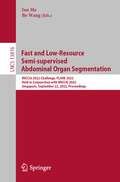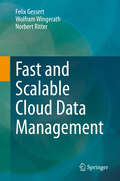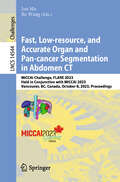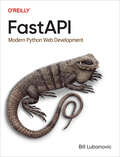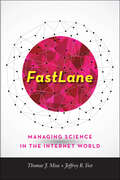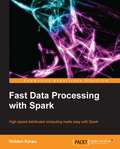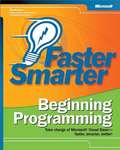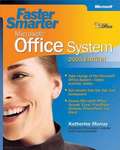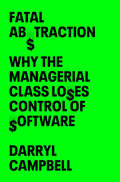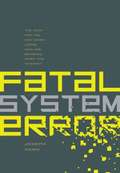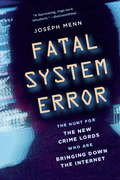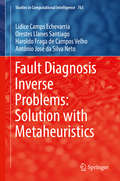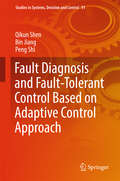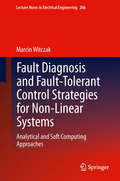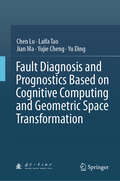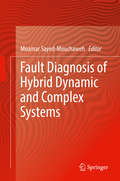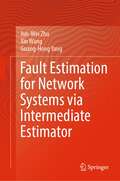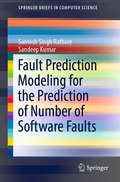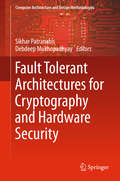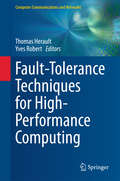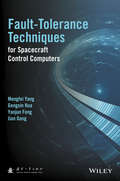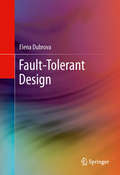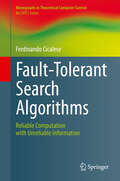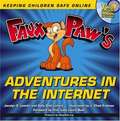- Table View
- List View
Fast and Low-Resource Semi-supervised Abdominal Organ Segmentation: MICCAI 2022 Challenge, FLARE 2022, Held in Conjunction with MICCAI 2022, Singapore, September 22, 2022, Proceedings (Lecture Notes in Computer Science #13816)
by Jun Ma Bo WangThis book constitutes the proceedings of the MICCAI 2022 Challenge, FLARE 2022, held in Conjunction with MICCAI 2022, in Singapore, on September 22, 2022. The 28 full papers presented in this book were carefully reviewed and selected from 48 submissions. The papers present research and results for abdominal organ segmentation which has many important clinical applications, such as organ quantification, surgical planning, and disease diagnosis.
Fast and Scalable Cloud Data Management
by Wolfram Wingerath Norbert Ritter Felix GessertThe unprecedented scale at which data is both produced and consumed today has generated a large demand for scalable data management solutions facilitating fast access from all over the world. As one consequence, a plethora of non-relational, distributed NoSQL database systems have risen in recent years and today’s data management system landscape has thus become somewhat hard to overlook. As another consequence, complex polyglot designs and elaborate schemes for data distribution and delivery have become the norm for building applications that connect users and organizations across the globe – but choosing the right combination of systems for a given use case has become increasingly difficult as well. To help practitioners stay on top of that challenge, this book presents a comprehensive overview and classification of the current system landscape in cloud data management as well as a survey of the state-of-the-art approaches for efficient data distribution and delivery to end-user devices. The topics covered thus range from NoSQL storage systems and polyglot architectures (backend) over distributed transactions and Web caching (network) to data access and rendering performance in the client (end-user).By distinguishing popular data management systems by data model, consistency guarantees, and other dimensions of interest, this book provides an abstract framework for reasoning about the overall design space and the individual positions claimed by each of the systems therein. Building on this classification, this book further presents an application-driven decision guidance tool that breaks the process of choosing a set of viable system candidates for a given application scenario down into a straightforward decision tree.
Fast, Low-resource, and Accurate Organ and Pan-cancer Segmentation in Abdomen CT: MICCAI Challenge, FLARE 2023, Held in Conjunction with MICCAI 2023, Vancouver, BC, Canada, October 8, 2023, Proceedings (Lecture Notes in Computer Science #14544)
by Jun Ma Bo WangThis book constitutes the proceedings of the MICCAI 2023 Challenge, FLARE 2023, held in Conjunction with MICCAI 2023, in Vancouver, BC, Canada, on October 8, 2023. The 27 full papers presented in this book were carefully reviewed and selected from 37 submissions. The papers present research and results for abdominal organ segmentation which has many important clinical applications, such as organ quantification, surgical planning, and disease diagnosis.
FastAPI: Modern Python Web Development
by Bill LubanovicFastAPI is a young yet solid framework that takes advantage of newer Python features in a clean design. As its name implies, FastAPI is indeed fast, rivaling similar frameworks in languages such as Golang. With this practical book, developers familiar with Python will learn how FastAPI lets you accomplish more in less time with less code.Author Bill Lubanovic covers the nuts and bolts of FastAPI development with how-to guides on various topics such as forms, database access, graphics, maps, and more that will take you beyond the basics. This book also includes how-to guides that will get you up to speed on RESTful APIs, data validation, authorization, and performance. With its similarities to frameworks like Flask and Django, you'll find it easy to get started with FastAPI.Through the course of this book, you will:Learn how to build web applications with FastAPIUnderstand the differences between FastAPI, Starlette, and pydanticLearn two features that set FastAPI apart: asynchronous functions and data type checking and validationExamine new features of Python 3.8+, especially type annotationsUnderstand the differences between sync and async PythonLearn how to connect with external APIs and services
FastLane: Managing Science in the Internet World (Johns Hopkins Studies in the History of Technology)
by Thomas J. Misa Jeffrey R. YostThe unique history and development of FastLane, the central nervous system of the National Science Foundation.Since 2000, the National Science Foundation has depended upon its pioneering FastLane e-government system to manage grant applications, peer reviews, and reporting. In this behind-the-scenes account Thomas J. Misa and Jeffrey R. Yost examine how powerful forces of science and computing came together to create this influential grant-management system, assessing its impact on cutting-edge scientific research.Why did the NSF create FastLane, and how did it anticipate the development of web-based e-commerce? What technical challenges did the glitch-prone early system present? Did the switch to electronic grant proposals disadvantage universities with fewer resources? And how did the scientific community help shape FastLane? Foregrounding the experience of computer users, the book draws on hundreds of interviews with scientific researchers, sponsored project administrators, NSF staff, and software designers, developers, and managers.
Fastdata Processing with Spark
by Holden KarauThis book will be a basic, step-by-step tutorial, which will help readers take advantage of all that Spark has to offer.Fastdata Processing with Spark is for software developers who want to learn how to write distributed programs with Spark. It will help developers who have had problems that were too much to be dealt with on a single computer. No previous experience with distributed programming is necessary. This book assumes knowledge of either Java, Scala, or Python.
Faster Smarter Beginning Programming
by Jim BuyensNow you can write your own programs with Microsoft® Visual Basic® .NET--faster, smarter, and better. Dive in--this friendly, high-energy guide makes it easy to learn exactly what you need. Use the numbered steps, code listings, and expert tips to accelerate your programming productivity--and move on to doing the cool things you want to do! Learn basic concepts, syntax, and language elements Follow easy coding techniques to build your dexterity Write and run your first Visual Basic .NET program Use built-in functions and classes or create your own Design the user interface with Windows® Forms Program Web applications using Microsoft ASP.NET Access files and databases Debug and deploy your new programs
Faster Smarter Microsoft® Office System -- 2003 Edition
by Katherine MurrayNow you can do the things you do every day with Office--create reports, manage finances, send e-mail, and make a presentation--but do them faster, smarter, and better. Dive in! This friendly, focused guide shows the best ways to use the core features in your Office programs, so you spend more time doing and less time learning. Use the quick lists, numbered steps, and helpful examples to accelerate your productivity--and do the cool things you want to do! Discover how to: Get your e-mail, calendar, and work day under control Create professional-looking documents--from memos and invoices to complex reports Use spreadsheets and charts to analyze data and support decision making Produce and deliver a compelling presentation with great visuals and special effects Communicate and work together more effectively using enhanced collaboration features Quickly build a dynamic Web site with data-driven features Use XML to make your data go farther Share and reuse information among programs to simplify work and get better resultsLearn about Office the Faster Smarter way! 10-Second Summary--see what each chapter covers at a glance Fast Wrap-Up--review key points and takeaways from every chapter Real-World Examples--apply what you learn to real work, right now Aha! Tips--get insider tips and insights to fuel your productivity Top 10 Troubleshooting Solutions--find fast answers, right inside the cover!
Fatal Abstraction: Why the Managerial Class Loses Control of Software
by Darryl CampbellA tech insider explains how capitalism and software development make for such a dangerous mix. Software was supposed to radically improve society. Outdated mechanical systems would be easily replaced; programs like PowerPoint would make information flow more freely; social media platforms like Facebook would bring people together; and generative AI would solve the world’s greatest ills. Yet in practice, few of the systems we looked to with such high hopes have lived up to their fundamental mandate. In fact, in too many cases they’ve made things worse, exposing us to immense risk at the societal and the individual levels. How did we get to this point? In Fatal Abstraction, Darryl Campbell shows that the problem is “managerial software”: programs created and overseen not by engineers but by professional managers with only the most superficial knowledge of technology itself. The managerial ethos dominates the modern tech industry, from its globe-spanning giants all the way down to its trendy startups. It demands that corporate leaders should be specialists in business rather than experts in their company’s field; that they manage their companies exclusively through the abstractions of finance; and that profit margins must take priority over developing a quality product that is safe for the consumer and beneficial for society. These corporations rush the development process and package cheap, unproven, potentially dangerous software inside sleek and shiny new devices. As Campbell demonstrates, the problem with software is distinct from that of other consumer products, because of how quickly it can scale to the dimensions of the world itself, and because its inner workings resist the efforts of many professional managers to understand it with their limited technical background. A former tech worker himself, Campbell shows how managerial software fails, and when it does what sorts of disastrous consequences ensue, from the Boeing 737 MAX crashes to a deadly self-driving car to PowerPoint propaganda, and beyond. Yet just because the tech industry is currently breaking its core promise does not mean the industry cannot change, or that the risks posed by managerial software should necessarily persist into the future. Campbell argues that the solution is tech workers with actual expertise establishing industry-wide principles of ethics and safety that corporations would be forced to follow. Fatal Abstraction is a stirring rebuke of the tech industry’s current managerial excesses, and also a hopeful glimpse of what a world shaped by good software can offer.
Fatal System Error
by Joseph MennIn 2004, a California computer whiz named Barrett Lyon uncovered the identity of a hacker running major assaults on business websites. Without fully grasping the repercussions, he set on an investigation that led him into the heart of the Russian mob. Cybercrime was evolving. No longer the domain of small-time thieves, it had been discovered by sophisticated gangs. They began by attacking corporate websites but increasingly stole financial data from consumers and defense secrets from governments. While Barrett investigated the cutting edge of technology crime, the U. S. government struggled to catch up. Britain, however, was a different story. In the late 1990s, the Queen herself had declared safe e-commerce a national security priority. Agents from the London-based National Hi-Tech Crime Unit sought out Barrett and enlisted his help. They also sent detective Andrew Crocker, a Welsh former boxer, to Russia to track down and prosecute the hackers--and to find out who they worked for. "Fatal System Error "penetrates both the Russian cyber-mob and the American mafia as the two fight over the Internet's massive spoils. It takes readers into the murky hacker underground, traveling the globe from San Francisco to Costa Rica, London, and Russia. Using unprecedented access to mob businesses and Russian officials, it shows how top criminals earned protection from the Russian government--and how Barrett Lyon and Andrew Crocker got closer to the titans of the underground economy than any previous outsider. Together, their stories explain why cybercrime is much worse than you thought--and why the Internet might not survive.
Fatal System Error: The Hunt for the New Crime Lords Who Are Bringing Down the Internet
by Joseph MennIn 2004, a California computer whiz named Barrett Lyon uncovered the identity of a hacker running major assaults on business websites. Without fully grasping the repercussions, he set on an investigation that led him into the heart of the Russian mob. Cybercrime was evolving. No longer the domain of small-time thieves, it had been discovered by sophisticated gangs. They began by attacking corporate websites but increasingly stole financial data from consumers and defense secrets from governments. While Barrett investigated the cutting edge of technology crime, the U.S. government struggled to catch up. Britain, however, was a different story. In the late 1990s, the Queen herself had declared safe e-commerce a national security priority. Agents from the London-based National Hi-Tech Crime Unit sought out Barrett and enlisted his help. They also sent detective Andrew Crocker, a Welsh former boxer, to Russia to track down and prosecute the hackers--and to find out who they worked for. Fatal System Error penetrates both the Russian cyber-mob and the American mafia as the two fight over the Internet's massive spoils. It takes readers into the murky hacker underground, traveling the globe from San Francisco to Costa Rica, London, and Russia. Using unprecedented access to mob businesses and Russian officials, it shows how top criminals earned protection from the Russian government--and how Barrett Lyon and Andrew Crocker got closer to the titans of the underground economy than any previous outsider. Together, their stories explain why cybercrime is much worse than you thought--and why the Internet might not survive.
Father, Son, and Company: My Life at IBM and Beyond
by Thomas J. Watson Jr. Peter PetreAlong with the story of a father and son, this is IBM's story too. It chronicles the management insights that shaped its course and its unique corporate culture, the style that made Thomas Watson Sr. one of America's most charismatic bosses, and the daring decisions by Thomas Watson Jr. that transformed IBM into the world's largest computing company. One of the greatest business-success stories of all time, "Father, Son & Co." is a moving lesson for fathers who dream for their children, as well as a testament to American ingenuity and values, told in a disarmingly frank and eloquent voice.
Fault Diagnosis Inverse Problems: Solution with Metaheuristics (Studies in Computational Intelligence #763)
by Orestes Llanes Santiago Lídice Camps Echevarría Haroldo Fraga Campos Velho Antônio José Silva NetoThis book presents a methodology based on inverse problems for use in solutions for fault diagnosis in control systems, combining tools from mathematics, physics, computational and mathematical modeling, optimization and computational intelligence. This methodology, known as fault diagnosis – inverse problem methodology or FD-IPM, unifies the results of several years of work of the authors in the fields of fault detection and isolation (FDI), inverse problems and optimization. The book clearly and systematically presents the main ideas, concepts and results obtained in recent years. By formulating fault diagnosis as an inverse problem, and by solving it using metaheuristics, the authors offer researchers and students a fresh, interdisciplinary perspective for problem solving in these fields. Graduate courses in engineering, applied mathematics and computing also benefit from this work.
Fault Diagnosis and Fault-Tolerant Control Based on Adaptive Control Approach
by Peng Shi Bin Jiang Qikun ShenThis book provides recent theoretical developments in and practical applications of fault diagnosis and fault tolerant control for complex dynamical systems, including uncertain systems, linear and nonlinear systems. Combining adaptive control technique with other control methodologies, it investigates the problems of fault diagnosis and fault tolerant control for uncertain dynamic systems with or without time delay. As such, the book provides readers a solid understanding of fault diagnosis and fault tolerant control based on adaptive control technology. Given its depth and breadth, it is well suited for undergraduate and graduate courses on linear system theory, nonlinear system theory, fault diagnosis and fault tolerant control techniques. Further, it can be used as a reference source for academic research on fault diagnosis and fault tolerant control, and for postgraduates in the field of control theory and engineering.
Fault Diagnosis and Fault-Tolerant Control Strategies for Non-Linear Systems
by Marcin WitczakThis book presents selected fault diagnosis and fault-tolerant control strategies for non-linear systems in a unified framework. In particular, starting from advanced state estimation strategies up to modern soft computing, the discrete-time description of the system is employed Part I of the book presents original research results regarding state estimation and neural networks for robust fault diagnosis. Part II is devoted to the presentation of integrated fault diagnosis and fault-tolerant systems. It starts with a general fault-tolerant control framework, which is then extended by introducing robustness with respect to various uncertainties. Finally, it is shown how to implement the proposed framework for fuzzy systems described by the well-known Takagi-Sugeno models. This research monograph is intended for researchers, engineers, and advanced postgraduate students in control and electrical engineering, computer science, as well as mechanical and chemical engineering.
Fault Diagnosis and Prognostics Based on Cognitive Computing and Geometric Space Transformation
by Jian Ma Yu Ding Chen Lu Laifa Tao Yujie ChengThis monograph introduces readers to new theories and methods applying cognitive computing and geometric space transformation to the field of fault diagnosis and prognostics. It summarizes the basic concepts and technical aspects of fault diagnosis and prognostics technology. Existing bottleneck problems are examined, and the advantages of applying cognitive computing and geometric space transformation are explained. In turn, the book highlights fault diagnosis, prognostic, and health assessment technologies based on cognitive computing methods, including deep learning, transfer learning, visual cognition, and compressed sensing. Lastly, it covers technologies based on differential geometry, space transformation, and pattern recognition.
Fault Diagnosis of Hybrid Dynamic and Complex Systems
by Moamar Sayed-MouchawehOnline fault diagnosis is crucial to ensure safe operation of complex dynamic systems in spite of faults affecting the system behaviors. Consequences of the occurrence of faults can be severe and result in human casualties, environmentally harmful emissions, high repair costs, and economical losses caused by unexpected stops in production lines. The majority of real systems are hybrid dynamic systems (HDS). In HDS, the dynamical behaviors evolve continuously with time according to the discrete mode (configuration) in which the system is. Consequently, fault diagnosis approaches must take into account both discrete and continuous dynamics as well as the interactions between them in order to perform correct fault diagnosis. This book presents recent and advanced approaches and techniques that address the complex problem of fault diagnosis of hybrid dynamic and complex systems using different model-based and data-driven approaches in different application domains (inductor motors, chemical process formed by tanks, reactors and valves, ignition engine, sewer networks, mobile robots, planetary rover prototype etc.). These approaches cover the different aspects of performing single/multiple online/offline parametric/discrete abrupt/tear and wear fault diagnosis in incremental/non-incremental manner, using different modeling tools (hybrid automata, hybrid Petri nets, hybrid bond graphs, extended Kalman filter etc.) for different classes of hybrid dynamic and complex systems.
Fault Estimation for Network Systems via Intermediate Estimator
by Xin Wang Guang-Hong Yang Jun-Wei ZhuThis book is concerned with the fault estimation problem for network systems. Firstly, to improve the existing adaptive fault estimation observer, a novel so-called intermediate estimator is proposed to identify the actuator or sensor faults in dynamic control systems with high accuracy and convergence speed. On this basis, by exploiting the properties of network systems such as multi-agent systems and large-scale interconnected systems, this book introduces the concept of distributed intermediate estimator; faults in different nodes can be estimated simultaneously; meanwhile, satisfactory consensus performances can be obtained via compensation based protocols. Finally, the characteristics of the new fault estimation methodology are verified and discussed by a series of experimental results on networked multi-axis motion control systems. This book can be used as a reference book for researcher and designer in the field of fault diagnosis and fault-tolerant control and can also be used as a reference book for senior undergraduate and graduate students in colleges and universities.
Fault Prediction Modeling for the Prediction of Number of Software Faults (SpringerBriefs in Computer Science)
by Sandeep Kumar Santosh Singh RathoreThis book addresses software faults—a critical issue that not only reduces the quality of software, but also increases their development costs. Various models for predicting the fault-proneness of software systems have been proposed; however, most of them provide inadequate information, limiting their effectiveness. This book focuses on the prediction of number of faults in software modules, and provides readers with essential insights into the generalized architecture, different techniques, and state-of-the art literature. In addition, it covers various software fault datasets and issues that crop up when predicting number of faults. A must-read for readers seeking a “one-stop” source of information on software fault prediction and recent research trends, the book will especially benefit those interested in pursuing research in this area. At the same time, it will provide experienced researchers with a valuable summary of the latest developments.
Fault Tolerant Architectures for Cryptography and Hardware Security (Computer Architecture and Design Methodologies)
by Debdeep Mukhopadhyay Sikhar PatranabisThis book uses motivating examples and real-life attack scenarios to introduce readers to the general concept of fault attacks in cryptography. It offers insights into how the fault tolerance theories developed in the book can actually be implemented, with a particular focus on a wide spectrum of fault models and practical fault injection techniques, ranging from simple, low-cost techniques to high-end equipment-based methods. It then individually examines fault attack vulnerabilities in symmetric, asymmetric and authenticated encryption systems. This is followed by extensive coverage of countermeasure techniques and fault tolerant architectures that attempt to thwart such vulnerabilities. Lastly, it presents a case study of a comprehensive FPGA-based fault tolerant architecture for AES-128, which brings together of a number of the fault tolerance techniques presented. It concludes with a discussion on how fault tolerance can be combined with side channel security to achieve protection against implementation-based attacks. The text is supported by illustrative diagrams, algorithms, tables and diagrams presenting real-world experimental results.
Fault-Tolerance Techniques for High-Performance Computing
by Thomas Herault Yves RobertThis timely text presents a comprehensive overview of fault tolerance techniques for high-performance computing (HPC). The text opens with a detailed introduction to the concepts of checkpoint protocols and scheduling algorithms, prediction, replication, silent error detection and correction, together with some application-specific techniques such as ABFT. Emphasis is placed on analytical performance models. This is then followed by a review of general-purpose techniques, including several checkpoint and rollback recovery protocols. Relevant execution scenarios are also evaluated and compared through quantitative models. Features: provides a survey of resilience methods and performance models; examines the various sources for errors and faults in large-scale systems; reviews the spectrum of techniques that can be applied to design a fault-tolerant MPI; investigates different approaches to replication; discusses the challenge of energy consumption of fault-tolerance methods in extreme-scale systems.
Fault-Tolerance Techniques for Spacecraft Control Computers
by Mengfei Yang Gengxin Hua Yanjun Feng Jian GongComprehensive coverage of all aspects of space application oriented fault tolerance techniques • Experienced expert author working on fault tolerance for Chinese space program for almost three decades• Initiatively provides a systematic texts for the cutting-edge fault tolerance techniques in spacecraft control computer, with emphasis on practical engineering knowledge• Presents fundamental and advanced theories and technologies in a logical and easy-to-understand manner• Beneficial to readers inside and outside the area of space applications
Fault-Tolerant Design
by Elena DubrovaThis textbook serves as an introduction to fault-tolerance, intended for upper-division undergraduate students, graduate-level students and practicing engineers in need of an overview of the field. Readers will develop skills in modeling and evaluating fault-tolerant architectures in terms of reliability, availability and safety. They will gain a thorough understanding of fault tolerant computers, including both the theory of how to design and evaluate them and the practical knowledge of achieving fault-tolerance in electronic, communication and software systems. Coverage includes fault-tolerance techniques through hardware, software, information and time redundancy. The content is designed to be highly accessible, including numerous examples and exercises. Solutions and powerpoint slides are available for instructors.
Fault-Tolerant Search Algorithms
by Ferdinando CicaleseWhy a book on fault-tolerant search algorithms? Searching is one of the fundamental problems in computer science. Time and again algorithmic and combinatorial issues originally studied in the context of search find application in the most diverse areas of computer science and discrete mathematics. On the other hand, fault-tolerance is a necessary ingredient of computing. Due to their inherent complexity, information systems are naturally prone to errors, which may appear at any level - as imprecisions in the data, bugs in the software, or transient or permanent hardware failures. This book provides a concise, rigorous and up-to-date account of different approaches to fault-tolerance in the context of algorithmic search theory. Thanks to their basic structure, search problems offer insights into how fault-tolerant techniques may be applied in various scenarios. In the first part of the book, a paradigmatic model for fault-tolerant search is presented, the Ulam--Rényi problem. Following a didactic approach, the author takes the reader on a tour of Ulam--Rényi problem variants of increasing complexity. In the context of this basic model, fundamental combinatorial and algorithmic issues in the design of fault-tolerant search procedures are discussed. The algorithmic efficiency achievable is analyzed with respect to the statistical nature of the error sources, and the amount of information on which the search algorithm bases its decisions. In the second part of the book, more general models of faults and fault-tolerance are considered. Special attention is given to the application of fault-tolerant search procedures to specific problems in distributed computing, bioinformatics and computational learning. This book will be of special value to researchers from the areas of combinatorial search and fault-tolerant computation, but also to researchers in learning and coding theory, databases, and artificial intelligence. Only basic training in discrete mathematics is assumed. Parts of the book can be used as the basis for specialized graduate courses on combinatorial search, or as supporting material for a graduate or undergraduate course on error-correcting codes.
Faux Paw's Adventures In The Internet: Keeping Children Safe Online
by Laura Bush Jacalyn Leavitt Sally Linford J. Chad Erekson"I encourage all adults to teach children the basic principles of online safety that are found in this book. " --First Lady Laura Bush, from the Foreword <P><P> Wait 'til you hear what almost happened to me! The Internet is like a big city with great places to go, but you have to be careful! I know. I had a REAL adventure on the Internet, and it wasn't the fun kind. When I tell you what almost happened, you'll see why it's so important to follow the rules for online safety! Read this book and you'll find out what I'm talking about. Keep safe, okay? G2G (that's "got to go" online--but you knew that!) These "3 KEEPs" help me keep safe online I KEEP SAFE all my personal information I KEEP AWAY from online strangers I KEEP TELLING my parents or a trusted adult what I see on the Internet <P> A word to adults If there's a child in your life who uses the Internet, it's your job to help them keep safe from online predators. <P> Created for the Internet Keep Safe Coalition, Faux Paw--an adventurous, six-toed, Web-surfing cat--is here to help! With a foreword by First Lady Laura Bush, this colorful book and animated movie will give kids wise advice and you a place to start talking to them.
